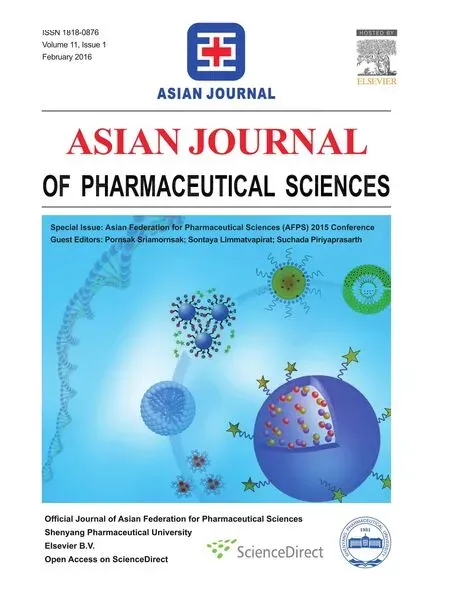Preparation and optimization of tocotrienol rich fraction(TRF)-loaded niosomes
M.SrvnnJ.Y.Fu
aSchool of Pharmacy,Monash University Malaysia,Bandar Sunway,47500 Selangor,Malaysia
bMalaysian Palm Oil Board,Bandar Baru Bangi,43000 Selangor,Malaysia
Preparation and optimization of tocotrienol rich fraction(TRF)-loaded niosomes
L.H.Chuaha,*,L.De Silvaa,M.Saravanana,J.Y.Fub
aSchool of Pharmacy,Monash University Malaysia,Bandar Sunway,47500 Selangor,Malaysia
bMalaysian Palm Oil Board,Bandar Baru Bangi,43000 Selangor,Malaysia
A R T I C L E I N F O
Article history:
Available online 24 November 2015
Niosomes
Tocotrienol
Drug delivery
Breast cancer
Vesicular delivery systems have gained much attention as pharmaceutical entities since their discovery.Niosomes occupy the general structure of bilayer vesicles,having a hydrophilic core shielded from one or multiple hydrophobic lipid bilayer.This unique structure enables them to both accommodate oilsoluble compounds as well as to encapsulate water-soluble drugs [1].The anticancer effects of tocotrienol were frst discovered in the early 1990s when Nesaretnam et al.reported that palm oil stripped of vitamin E-promoted tumorigenesis in rats[2].In 2006,the frst clinical trial of tocotrienol in breast cancer was conducted.The risk of mortality due to breast cancer was 60% lower when tocotrienol rich fraction(TRF)was given together with tamoxifen.Five-year breast cancer specifc survival and disease free survival were also slightly improved with adjuvant tocotrienol therapy[3].In this study,we aim to prepare and optimize a formulation of niosomes loaded with tocotrienol rich fraction(TRF)for potential delivery to breast cancer.
Niosomes loaded withTRF were prepared using 146.4 mg span 60,131.4 mg cholesterol and 102.9 mgTPGS.TRF of varying concentrations(10 mg/mL–30 mg/mL)were added into the mixture and stirred at 450 rpm for 1 h at 90°C.After which the samples were subjected to probe sonication at 75%of the maximum capacity using QSonica Q125 probe sonicator for 6 minutes.The samples were then ultracentrifuged(Beckman Coulter Optima?L-100 XP)at 40,000 rpm for 6 hours at 4°C to remove free unbound materials.The niosomes were then collected from the pellet and resuspended in PBS.The niosomes were freezedried for 3 days and resuspended in PBS before use.The size of the niosomes was measured using Nano-Zetasizer(Malvern Instruments,UK).TRF loading were determined by HPLC.Different concentrations of TRF yield niosomes with slightly different sizes.The sizes are in the range of 300–400 nm.The %ofTRF loaded onto the niosomes also differ,in a general trend of increasing amount loaded with increasing concentration of TRF used.Based on the results on size andTRF loading,niosomes prepared with TRF loading of 25 mg/mL appeared to be the optimal preparation with average size of 298.25 nm and 11.96% TRF loading.
This preliminary study showed that TRF can be successfully loaded onto the niosomes,and the optimal preparationwas selected based on size and amount of loadedTRF.Further studies will be carried out to determine the morphology of the niosomes using scanning electron microscope,as well as to determine the TRF release from the niosomes.

Fig.1–Graphs showing(a)size and(b)percentage TRF loading of niosomes prepared with varying concentrations of TRF.
Acknowledgements
This is supported and funded by Malaysian Palm Oil Board (PD202/15)and the Fundamental Research Grant Scheme (FRGS)by the Ministry of Higher Education,Malaysia (FRGS/2/2014/SG05/MUSM/03/35).
R E F E R E N C E S
[1]Malmsten M.Surfactants and polymers in drug delivery.New York:Marcel Dekker,Inc.;2002.
[2]Nesaretnam K,Guthrie N,Chambers AF,et al.Effect of tocotrienols on the growth of human breast cancer cell line in culture.Lipids 1992;30:1139–1145.
[3]Nesaretnam K,Selvaduray KR,Abdul RG,et al.Effectiveness of tocotrienol-rich fraction combined with tamoxifen in the management of women with early breast cancer:a pilot clinical trial.Breast Cancer Res 2010;12:R81.
*E-mail address:alice.chuah@monash.edu.
Peer review under responsibility of Shenyang Pharmaceutical University.
http://dx.doi.org/10.1016/j.ajps.2015.10.042
1818-0876/?2016 The Authors.Production and hosting by Elsevier B.V.on behalf of Shenyang Pharmaceutical University.This is an open access article under the CC BY-NC-ND license(http://creativecommons.org/licenses/by-nc-nd/4.0/).
 Asian Journal of Pharmacentical Sciences2016年1期
Asian Journal of Pharmacentical Sciences2016年1期
- Asian Journal of Pharmacentical Sciences的其它文章
- Determination of the antidepressant effect of mirtazapine augmented with caffeine using Swiss-albino mice
- Photosafety testing of dermally-applied chemicals based on photochemical and cassette-dosing pharmacokinetic data
- Biopharmaceutics classifcation system(BCS)-based biowaiver for immediate release solid oral dosage forms of moxifoxacin hydrochloride (Moxifox GPO)manufactured by the Government Pharmaceutical Organization(GPO)
- Bioequivalence study of abacavir/lamivudine (600/300-mg)tablets in healthy Thai volunteers under fasting conditions
- Evaluation of cytotoxic and infammatory properties of clove oil microemulsion in mice
- Analytical method development of pregabalin and related substances in extended release tablets containing polyethylene oxide
